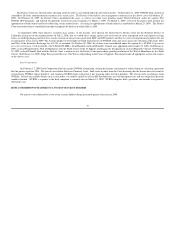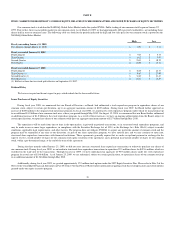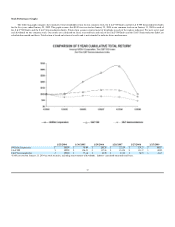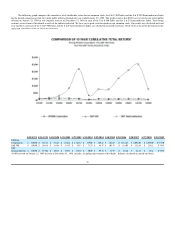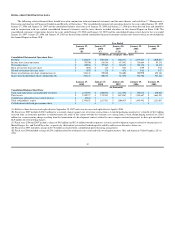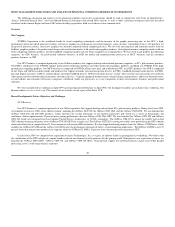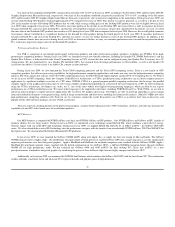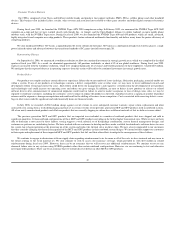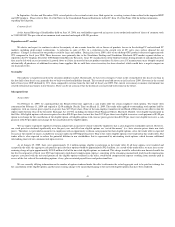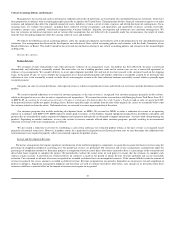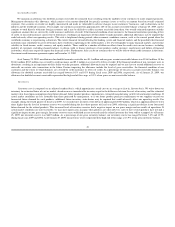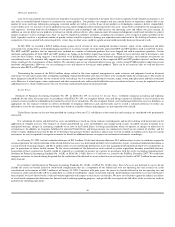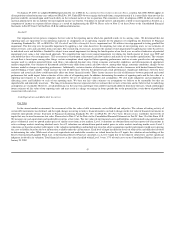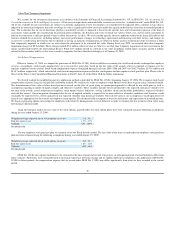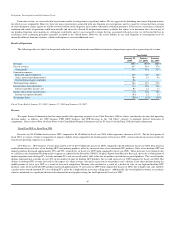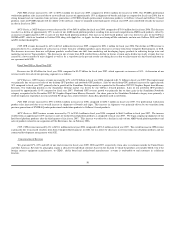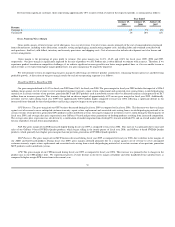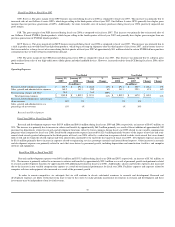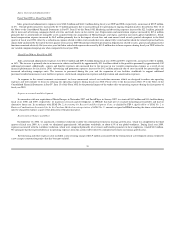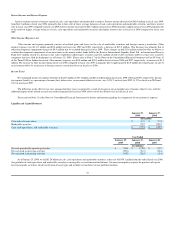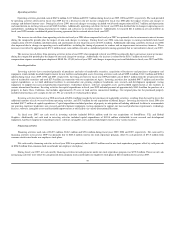NVIDIA 2008 Annual Report Download - page 48
Download and view the complete annual report
Please find page 48 of the 2008 NVIDIA annual report below. You can navigate through the pages in the report by either clicking on the pages listed below, or by using the keyword search tool below to find specific information within the annual report.
Accounts Receivable
We maintain an allowance for doubtful accounts receivable for estimated losses resulting from the inability of our customers to make required payments.
Management determines this allowance, which consists of an amount identified for specific customer issues as well as an amount based on overall estimated
exposure. Our accounts receivable are highly concentrated and make us vulnerable to adverse changes in our customers' businesses, and to downturns in the
industry and the worldwide economy. For example, one customer accounted for approximately 18% of our accounts receivable balance at January 25, 2009, and we
continue to work directly with more foreign customers and it may be difficult to collect accounts receivable from them. Our overall estimated exposure excludes
significant amounts that are covered by credit insurance and letters of credit. If the financial condition of our customers, the financial institutions providing letters
of credit, or our credit insurance carrier were to deteriorate, resulting in an impairment of their ability to make payments, additional allowances may be required that
could adversely affect our operating results. This risk is heightened during periods when economic conditions worsen, such as the current period when the
worldwide economy is experiencing a downturn. The current financial turmoil affecting the banking system and financial markets and the possibility that financial
institutions may consolidate or go out of business have resulted in a tightening in the credit markets, a low level of liquidity in many financial markets, and extreme
volatility in fixed income, credit, currency and equity markets. There could be a number of follow
-
on effects from the credit crisis on our business, including
inability of customers, including channel partners, to obtain credit to finance purchases of our products and/or customer, insolvencies and failure of financial
institutions, which may negatively impact our financial results. Furthermore, there can be no assurance that we will be able to obtain credit insurance in the future.
Our current credit insurance agreement expires on December 31, 2009.
As of January 25, 2009, our allowance for doubtful accounts receivable was $1.1 million and our gross accounts receivable balance was $336.8 million. Of the
$336.8 million, $94.5 million was covered by credit insurance and $5.3 million was covered by letters of credit. If the financial condition of our customers were to
deteriorate, resulting in an impairment of their ability to make payments, additional allowances may be required and we may have to record additional reserves or
write
-
offs on certain sales transactions in the future. Factors impacting the allowance include the level of gross receivables, the financial condition of our
customers and the extent to which balances are covered by credit insurance or letters of credit. As a percentage of our gross accounts receivable balance, our
allowance for doubtful accounts receivable has ranged between 0.1% and 0.3% during fiscal years 2009 and 2008, respectively. As of January 25, 2009, our
allowance for doubtful accounts receivable represented the high end of this range, at 0.3% of our gross accounts receivable balance.
Inventories
Inventory cost is computed on an adjusted standard basis; which approximates actual cost on an average or first
-
in, first
-
out basis. We write down our
inventory for estimated lower of cost or market, obsolescence or unmarketable inventory equal to the difference between the cost of inventory and the estimated
market value based upon assumptions about future demand, future product purchase commitments, estimated manufacturing yield levels and market conditions. If
actual market conditions are less favorable than those projected by management, or if our future product purchase commitments to our suppliers exceed our
forecasted future demand for such products, additional future inventory write
-
downs may be required that could adversely affect our operating results. For
example, during the fourth quarter of fiscal year 2009, we recorded new inventory write
-
downs of approximately $50.0 million, which was approximately five to ten
times higher than the level of inventory reserves we recorded during the first three quarters of fiscal year 2009, reflecting a significant decline in our forecasted
future demand for the related products. This increased level of inventory reserves had a negative impact on our gross margin and our results of operations. If
actual market conditions are more favorable, we may have higher gross margins when products are sold, however, sales to date of such products have not had a
significant impact on our gross margin. Inventory reserves once established are not reversed until the related inventory has been sold or scrapped. As of January
25, 2009, our inventory reserve was $86.9 million. As a percentage of our gross inventory balance, our inventory reserve has ranged between 7.8% and 13.9%
during fiscal years 2009 and 2008. As of January 25, 2009, our inventory reserve represented the high end of this range at 13.9% of our gross inventory balance.
45


